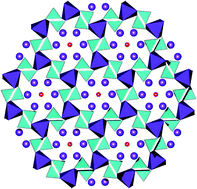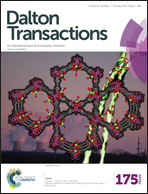Neutron diffraction and multinuclear solid state NMR investigation into the structures of oxide ion conducting La9.6Si6O26.4 and La8Sr2Si6O26, and their hydrated phases
Abstract
Apatite silicates are attracting significant interest as potential SOFC electrolyte materials. They are non-conventional oxide ion conductors in the sense that oxide ion interstitials, rather than vacancies, are the key defects. In this work we compare the structures of La9.6Si6O26.4 and La8Sr2Si6O26, both before and after hydration in order to gather information about the location of the interstitial oxide ion site. Neutron diffraction structural studies suggest that in the as-prepared La8Sr2Si6O26 and hydrated La8Sr2Si6O26, the interstitial oxide ion sites are close to the apatite channel centre. For La9.6Si6O26.4, a similar site close to the channel centre is observed, but on hydration of this particular sample, the interstitial site is shown to be significantly displaced away from the channel centre towards the SiO4 units. This can be explained by the need for additional displacement from the channel centre to accommodate the large amount of interstitial anions in this hydrated phase. The solid state 29Si MAS NMR spectra are shown to be very sensitive to the different speciation exhibited by the La8Sr2Si6O26 and La9.6Si6O26.4 systems, with the former being dominated by regular SiO4 framework species and the latter being dominated by interruptions to this network caused by cation vacancies and interstitials. The corresponding 17O MAS NMR study identifies a strong signal from the O atoms of the SiO4 groups, thus demonstrating that all of the O species in these systems are exchangeable O under heterogeneous gas phase conditions. In addition, interstitial O species attributed to pendant OH linkages on the Si positions are clearly identified and resolved, and these are removed on dehydration. This observation and assignment is corroborated by corresponding 1H MAS NMR measurements. Overall the neutron diffraction work indicates that the interstitial site location in these apatite silicates depends on the anion content with progressive displacement towards the SiO4 tetrahedra on increasing anion content, while the observation of exchangeable O on the SiO4 groups is consistent with prior modelling predictions as to the importance on the silicate units in the conduction process.


 Please wait while we load your content...
Please wait while we load your content...